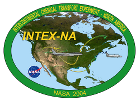The Intercontinental Chemical Transport Experiment – North America (INTEX-NA) was an integrated field campaign which quantified and characterized the transport of gases and aerosols on transcontinental and intercontinental scales. INTEX-A, the first phase of this experiment, was conducted in the summer of 2004. The second phase of the mission, INTEX-B, was conducted in the spring of 2006. The movement of gases and aerosols on intercontinental scales can have impacts on the global atmosphere, and those impacts can in turn affect regional air quality. INTEX-A's exploration of the movement of pollution across North America helped to inform the understanding of the sources and sinks of trace gases and aerosols, of the relations between chemical source regions and the global atmosphere, and of how humans influence climate and air quality.
INTEX-A's primary objective was to characterize the outflow of pollution over North America to the Atlantic Ocean. INTEX-A also had the objective of understanding the impacts of pollution transport on atmosphere, air quality, and climate on both global and regional scales. Another science objective was to validate satellite observations (particularly from NASA’s Aura satellite and the European Space Agency Envisat satellite). This study also sought to characterize the composition of the North American troposphere, to understand the sources and sinks of gases and aerosols, and to investigate aerosol radiative properties.
INTEX-A was conducted in June and July of 2004, and had a geographic focus on the eastern United States and the Atlantic Ocean. The planning of this first phase for summer addressed the peak season for issues involving aerosols and the carbon cycle.
The NASA DC-8, the J-31, the NOAA WP-3D, and the Proteus aircraft were the primary airborne platforms used in INTEX-A. These platforms were equipped with in-situ and remote sensing instruments that provided chemical, physical, and optical measurements of long-lived greenhouse gases, ozone, ozone precursors, aerosols, aerosol precursors, radicals, radical reservoirs, chemical tracers of sources and transport, and optical parameters. Five other aircraft collected additional airborne data. Several fixed surface air quality stations complemented these airborne platforms. Additionally, the NOAA Research Vessel Ronald H. Brown (R/V R.H. Brown) provided ship-based data related to the outflow of pollution in the Gulf of Maine. INTEX-A leveraged data from the Terra, Aqua, Aura, and Envisat satellites, as well as using data from surface networks and sondes. Lastly, INTEX-A used meteorological and chemical forecasts from various groups for flight planning purposes and post-mission data analysis.
The ASDC houses INTEX-A data from the DC-8, J-31 and Proteus aircraft. This aircraft data includes merged data and aircraft trajectory data for the DC-8. Additionally, the ASDC houses model data, ozonesonde data, and satellite data. The ASDC also houses INTEX-A data collected through AIRMAP, a program to study pollutants involved in the INTEX mission sponsored by NOAA and the University of New Hampshire.
INTEX-A Project Page
Disciplines: Aerosols Tropospheric Composition Field Campaigns
| Collection | Disciplines | Spatial | Temporal |
|---|---|---|---|
|
INTEXA_AIRMAP_1
INTEX-A AIRMAP data |
Aerosols |
Spatial Coverage: (S: 27, N: 54), (W: -178, E: -132) |
Temporal Coverage: 2004-07-05 - 2004-07-05 |
|
INTEXA_DC8_AIRCRAFT_1
INTEX-A Aircraft data |
Aerosols |
Spatial Coverage: (S: 27, N: 54), (W: -177.1, E: -132) |
Temporal Coverage: 2004-06-26 - 2004-08-14 |
|
INTEXA_J31_AIRCRAFT_1
INTEX-A J-31 Aircraft data |
Aerosols |
Spatial Coverage: (S: 40, N: 45), (W: -72, E: -63) |
Temporal Coverage: 2004-07-10 - 2004-08-08 |
|
INTEXA_MERGES_1
INTEX-A Merged DC-8 Aircraft data |
Aerosols |
Spatial Coverage: (S: 27, N: 54), (W: -178, E: -132) |
Temporal Coverage: 2004-07-01 - 2004-08-14 |
|
INTEXA_MODEL_1
INTEX-A Model data |
Aerosols |
Spatial Coverage: (S: 26, N: 55), (W: -178, E: -132) |
Temporal Coverage: 2004-06-26 - 2004-08-14 |
|
INTEXA_O3SONDES_1
INTEX-A Ozonesonde data |
Aerosols |
Spatial Coverage: (S: 28, N: 46), (W: -106, E: -59) |
Temporal Coverage: 2004-07-01 - 2004-08-13 |
|
INTEXA_PROTEUS_AIRCRAFT_1
INTEX-A Proteus Aircraft data |
Aerosols |
Spatial Coverage: (S: 28.79, N: 43.18), (W: -118.04, E: -68.1) |
Temporal Coverage: 2004-07-19 - 2004-07-26 |
|
INTEXA_SATELLITE_1
INTEX-A Satellite data |
Aerosols |
Spatial Coverage: (S: 27.5, N: 53.05), (W: -177, E: -133) |
Temporal Coverage: 2004-06-20 - 2004-08-31 |
|
INTEXA_TRAJECTORY_1
INTEX-A DC-8 Aircraft Trajectory data |
Aerosols |
Spatial Coverage: (S: 26, N: 57), (W: -178, E: -132) |
Temporal Coverage: 2004-07-01 - 2004-08-14 |
INTEXA Mission Publications
Marais, Eloise A.; Jacob, Daniel J.; Choi, Sungyeon; Joiner, Joanna; Belmonte-Rivas, Maria; Cohen, Ronald C.; Beirle, Steffen; Murray, Lee T.; Schiferl, Luke D.; Shah, Viral; Jaeglé, Lyatt (2020). Nitrogen oxides in the global upper troposphere: interpreting cloud-sliced NO2 observations from the OMI satellite instrument.
